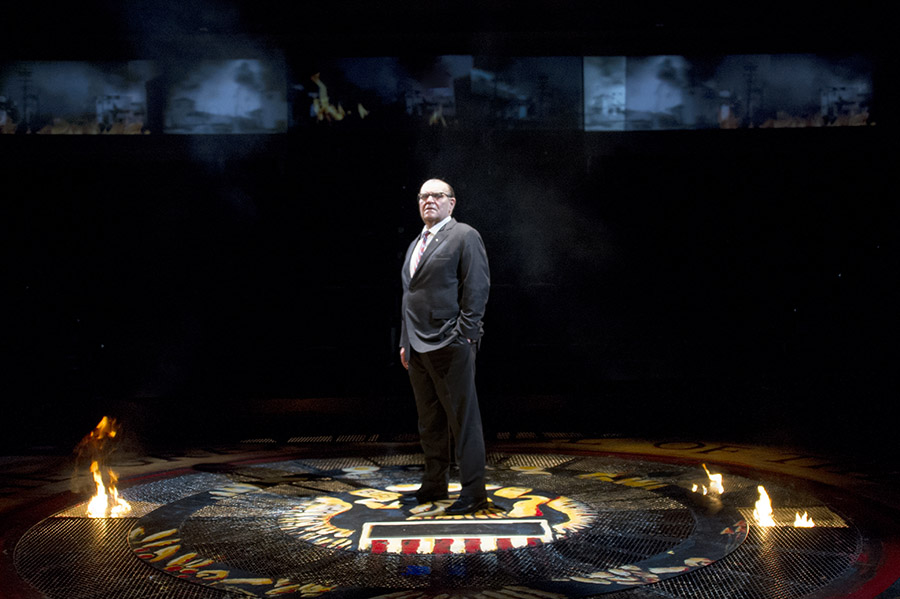 It will take biographer Robert Caro five volumes to complete his portrait of Lyndon B. Johnson, so it’s no surprise that there’s a second LBJ play from Robert Schenkkan.
It will take biographer Robert Caro five volumes to complete his portrait of Lyndon B. Johnson, so it’s no surprise that there’s a second LBJ play from Robert Schenkkan.
His first, “All the Way,” about Johnson’s first year in office and passage of the Civil Rights act, was a Tony-winner on Broadway and adapted for an Emmy-nominated film on HBO, both starring Bryan Cranston.
The sequel, at the Arena Stage, is named after the president’s domestic program, “The Great Society,” and covers about the balance of his years in office, from his election win to fighting further for voting rights (though not enough for activists), and trying to get money for new ideas like Medicare, even as he mires the country further into Vietnam and battles political foes on the right and left.
Jack Willis, who originated the role in “All the Way” returns as LBJ once more, as feisty and cantankerous as his appearance in the first play here two years ago. A further treat of continuity for those who saw the earlier “All the Way” is that a dozen of the cast members from the “All the Way” return as well. Among them are Bowman Wright’s stoic Martin Luther King, who is seen to have quite a lot of interaction with the President, to Tom Wiggin as the bespectacled Robert McNamara, Richmond Hoxie as an almost Nixonian J. Edgar Hoover, and Cameron Folmar as a defiant George Wallace. Susan Rome also reprises her role as Lady Bird Johnson, though she isn’t seen too often as the President has his hands full in political crises.
One change has Lawrence Redmond promoted, in a sense, from portraying Sen. Richard Russell last time out to Vice President Hubert Humphrey in the current production. With his pugnacious stature and chirpy voice, there’s no question who he plays, although with Willis, it takes a while to adjust to the portrayal because he doesn’t necessarily physically resemble the President. His imposing nature, and tendency to lean into those with whom he is sparring conjures up, however, what many remember about the man.
Since premiering at the Oregon Shakespeare Theatre (where the first one debuted as well), Schenkkan has trimmed his three act play into two. And while it is still quite lengthy at two and a half hours, there is an awful lot to pack in from January, 1965, where LBJ celebrates his inaugural and state of the union, to the end of 1968, when he shows the White House to his successor, Richard Nixon (also Folmar).
This means director Kyle Donnelly has to keep things really moving, and she does, with a lot more Civil Rights marches than one might expect (from the way LBJ generally steered clear of them). The pace seems to affect Willis as well. While many might remember Johnson with a softer, more languorous drawl, especially when he was speaking to the public; Willis’ president is much more insistent. It differs quite a bit from the Johnson we hear as part of radio’s most compelling weekly drama — the replay of private phone conversations from the Johnson White House that CSPAN broadcasts Saturday nights.
While many of the key historical moments of the era are shortened or bypassed (I suspect the assassinations of 1968 figured more prominently in the earlier version), one aspect Schenkkan did not cut were the many down-home stories and frontier similes that made Johnson such a singular figure.
There might be one more such shaggy dog tale than they need, but the stories help humanize the president and provide a break in the middle of the policy debates.
Kate Edmunds’ set in the round is organized once more around a large Presidential seal, but instead of revolving this time, groups of people (and desks and podiums) roll on and off stage as it turns from Oval Office to a dozen different locals, often with the number of American war dead in Vietnam flashing on well used screens by projection designer Aaron Rhyne.
The fixed metal grid of the stage allows for actual flames to dramatically shoot up from its surface at key points, during urban uprisings or when a Quaker protestor in 1965 immolated himself outside of McNamara’s office and forever changed the Secretary of Defense’s mind on the war.
There is terrific stagecraft, too, in depicting the ongoing war horrors when a fallen soldier is dragged around the perimeter of the stage seal, literally ringing the presidency in blood. For all the annoyance of rivals and political back-stabbers, the full weight of Willis’ remarkable performance is seen when he has to write individual letters to the grieving families of the war dead.
American history and the intricacies of lawmaking will forever be of interest in this town, and for that reason alone, “The Great Society” shouldn’t be missed, especially as the very programs it discusses are still up for discussion in a Congress that was debating, on opening night, whether to shut down for the second time this year.
Schenkkan lays off the obvious contrasts with the current time for the most part, but can’t resist having the incoming Nixon utter a phrase that will certainly chill audiences a half century later.
“The Great Society” runs through March 11 at Arena Stage, Washington, DC.